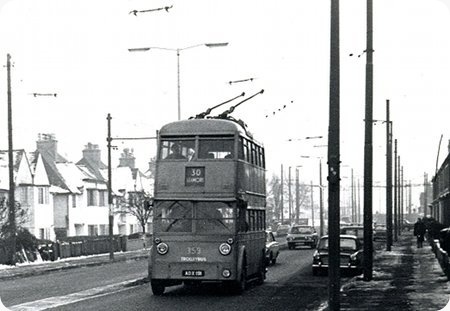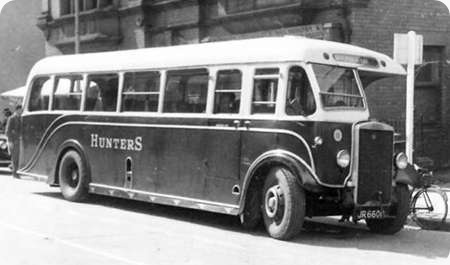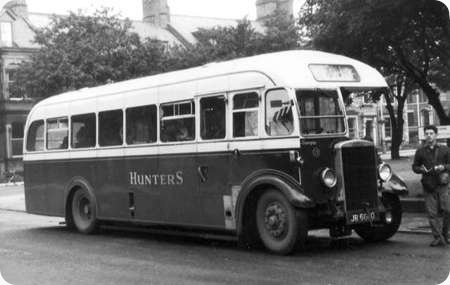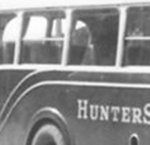Alex Moulton – Moulton – Unregistered
Alex Moulton
Moulton
1970
Moulton C23F
The Moulton was developed by Dr Alex Moulton of "folding bicycle and rubber suspension for cars" fame. He died, aged 92, early in December 2012. The coach was built in 1970 and is a one off. This curious-looking beast is now in the care of the Science Museum and resides at their Annexe at Wroughton Airfield, near Swindon, where I captured it on film during one of their too-rare open days, on 12 July, 1986. The bodywork, also by Moulton, seats 23 according to the PSV Circle listing. The vehicle was never registered for use on public roads.
The adjacent vehicle is a Bedford VAL/Duple new to and preserved in the livery of Reliance, Newbury: altogether more conventional in the "vehicles with three or more axles" department!
Photograph and Copy contributed by Pete Davies
06/01/13 – 07:09
Shows a certain amount of commonality with the Leyland Commutabus. This was the 1965 culmination of 1950/60s experimental work which laid the way for the Leyland National.
David Oldfield
06/01/13 – 11:21
I believe that the Moulton coach is available for sale to the right person. As part of the Science Museum’s quest to downsize its non-core exhibits, it is willing to part with this vehicle, for the right price, to someone or an organisation that will keep it in the right conditions (and probably to continue to allow public access). But as it has never been road-licenced, it would be a real challenge to get it certified at this stage in its life, with its range of strange features, in accordance with VOSA’s requirements.
Petras409
06/01/13 – 13:09
Can someone give us a run-down on the "strange features?"
-Perkins V8?
-Space frame giving lightness and flexibility of body shape?
Suspension? Independent? Rubber?
Two steering axles, two driving… or a FWD bus??!
Ventilation?
Joe
06/01/13 – 18:09
Sorry, Joe. all I know about the beast is in the caption.
Pete Davies
06/01/13 – 18:10
More pictures of this coach may be found here-: www.flickr.com/photos/
Roger Cox
06/01/13 – 18:10
It would be a complicated process, as the design has never been homologated for road use. Assuming it could be (and the Perkins V8 alone would almost certainly disqualify it under current regulations) you would have a mammoth task trying to build up a case for permitting this design to run on the road subject only to 1970s legislation. I don’t see anybody considering that task, with no guarantee of success, worthwhile, particularly when you consider that it would only run limited mileage due to its historic status.
Much simpler to give it an occasional run on a test circuit and avoid the bother!
David Beilby
07/01/13 – 15:38
Thanks Roger for the flickr ref which answers the questions. Wonderful, isn’t it! Lord Stokes- it seems- rejected it and drove away (metaphorically) away in his Triumph Herald.
Joe
07/01/13 – 15:39
Judging by the cab view in the Flickr set (thanks to Roger for the link) it looks a flimsy machine. Bedford running units? And quite apart from the air pollution hinted at by David B, I’m sure the screaming V8 would have blown itself up before long. The whole thing would have made the Bedford VAL look like a paragon of long component life and reliability. Forgive my blatant prejudices…
Ian Thompson
07/01/13 – 15:39
I hope it finds a good home as its certainly unique. I know this will sound a bit flippant, but it looks like the kind of thing you would expect to see on Thunderbirds.
Ronnie Hoye
07/01/13 – 15:40
With apologies for those not of a ‘certain age’ but maybe Mr Moulton was influenced by those Gerry Anderson "supermarionation" programmes like ‘Thuderbirds’? Perhaps this was a full-size mock-up of "FAB – 3" which might have stood for "Fairly Awful Bus"!
Paul Haywood
08/01/13 – 07:33
Ian- read the Science Museum description again: the idea was body strength and suspension. The engine/transmission was surely just a prototype. A very impressive machine and an indication of how British Engineering missed its way… could this have been our Setra? Lady Penelopes car was more VAL/Vauxhall- twin front axle and ghastly styling- in pink!
Joe
08/01/13 – 09:37
I thought this contribution might generate some comment. I’m a bit surprised there isn’t more!!!
Pete Davies
08/01/13 – 10:46
Maybe give it a run out at Sandtoft or Beamish.
Mr Anon
08/01/13 – 11:44
"Parker – get the Moulton ready to roll."
"Yes mi’ lady!"
Stephen Ford
08/01/13 – 16:15
I trawled obituaries for Alex Moulton and only one mentioned his coach. I paraphrase what was written: "Apparently, in 1969, he produced a revolutionary motor coach and invited Lord Stokes, then chairman of BMC, to his home, in order to examine the prototype. Moulton recalled: “He was supercilious: ‘Oh No, we couldn’t possibly do that.’”"
Chris Hebbron
08/01/13 – 18:08
As I said Chris- he drove off in his virtual Triumph Herald which was his tour de force in rescuing Triumph – but I think that is as far as he was going. Moulton’s obituaries are interesting: try reading them with Otto Kässbohrer who also took over a family firm and started producing self-supporting coaches (Setra). Moulton took over the family rubber firm and designed rubber suspensions for Minis, and then hydrolastic for cars and space-frame……coaches? I rest my case!
Joe
09/01/13 – 05:40
Moulton coach, original brief from BMC, fit your suspension to a Thornycroft 7 ton lorry, suspension good but chassis too weak allowing wheel hop. Lorry studies abandoned.
A stiff structure was required, ie the coach with a spaceframe body/chassis as a tubular all over "cage". When fitted with the Moulton "road bogies" the vehicle rode better than all else, BMC ordered the vehicle to be scrapped, "not invented here syndrome"
Dr Moulton ignored the instruction, hence the preserved one-off.
How nice to see this vehicle roadworthy again.
MM
09/01/13 – 15:58
Thanks to comments by Joe, MM and others I now realise that the Moulton was a serious project and not just a marketing department’s "concept (ugh!)!" vehicle, as I’d assumed it was. Chris H’s mention of Donald Stokes’s contemptuous dismissal of the Moulton prototype reminds me that as I was having a look round the Ailsa at the 1974 London Commercial Motor Show, tape-measure in hand and probably making admiring noises, someone sitting upstairs asked me what I thought of it. Having listened patiently to my enthusiastic but probably not very well-informed eulogy of the design, he said quietly "Well, I designed it. Glad you like it. My name’s Norman Watson. I work[ed] for Scammell at Watford, Herts. Donald Stokes doesn’t think much of it, though!" Somehow, I think Norman had the last laugh…
Ian Thompson
10/01/13 – 06:48
As someone who has driven Maxis, owned Allegros and Metros, and currently owns four Rover 100s (and whose contempt for Clarkson’s opinions is unequalled) I can confirm that the Moulton suspension concepts work extremely well. It does not surprise me in the least that Donald Stokes, a salesman rather than an engineer, should dismiss Moulton’s ideas out of hand. Once Stokes got his hand on the tiller of the once great ship "Leyland", it was full speed ahead for the rocks and oblivion.
Roger Cox
10/01/13 – 11:55
To be fair, ‘Red’ Robbo and his trade union cohorts hardly helped the whole unsavoury scenario.
Chris Hebbron
10/01/13 – 17:30
Stokes was a classic example of the Peter Principle in action. An excellent bus salesman but promoted far beyond his abilities and arrogant with it.
Having messed up the industry it was inevitable in this country that we gave him a knighthood and then a peerage.
You couldn’t make it up.
Paragon
11/01/13 – 05:23
It was ironic that Donald Stokes, salesman "par excellence" should have been duped into agreeing to a merger of LMC and BMC (Build More C**p) when BMC was teetering on the edge of bankruptcy. It was the subsequent siphoning of funds to keep the ailing ex-BMC car/light-van business afloat that did for BLMC (Build Lots More C**p) – and as Chris says the Luddite (lemming?) tendencies of the car-workers at Longbridge didn’t help. Yet there was still a chance of salvation: I’ve read somewhere [and I will post the source if I ever come back to find it] that, in the early 1970s, GKN (steel manufacturers) wanted to purchase the Austin-Morris volume car/van business from BLMC – shorn of this, and concentrating on sports cars/executive/luxury cars (MG, Triumph, Rover, Jaguar/Daimler), 4x4s (Land Rover/Range Rover) and commercials (AEC, blah . . .), the future may have been so different.
Perhaps if (B)LMC had also sold on non-core activities – like Aveling-Barford/Aveling-Marshall (construction equipment), pedal-cars (factory closed 1971), Coventry Climax/Coventry Conveyancer (fork-lifts, fire pumps, competition/maine/military engines), Prestcold (refigeration equipment), Avon Bodies (body repairs and the odd hearse), Alvis (military vehicles) . . . and I don’t even know what Beans Industries, West Yorkshire Foundries, Alford & Alder (Engineers), British Gear Grinding & Manufacturing, Goodwin Barsby & Co, Barfords of Belton, Invicta Bridge & Engineering, and Grantham Electrical Engineering were doing or what their relevance to the core activity of BLMC was . . . earlier then the outcome for these businesses (many subsequently failed) would have been different too.
I’m not a BL-basher, I stuck with Rover to the bitter end (and when my father bought a new Triumph Dolomite [c.1972] was he proud!) – but now my wife and I run VAG-group cars (and now I know why MG_Rover failed). When I catch the bus to work next week it will be Volvo or Scania that pulls up. As an engineer I could cry.
But back to the Moulton! As an engineer I could rave about the engineering innovations and reported ride quality, but I’m with Ian’s views of 7/01: how much more work/development would have needed to take this design forwards to a viable project? AND if the design offered so many advantages why wasn’t it subsequently adopted by any manufacturer?: and as far as car suspension goes where are "Hydrolastic"(?) and, for that matter "Hydragas", suspension systems now? . . . Tooting Broadway, 5:45, mid-week, is not when you want your cars suspension to give up the ghost – believe me.
Philip Rushworth
11/01/13 – 08:38
I’m not too sure that Stokes was duped. Rather he was frog marched into the merger and then became enamoured with the level of power he found he wielded and his proximity to the levers of national policy.
The period spawned the appalling idea which has dominated British business ever since – "management experience in any given industry means the ability to manage any other".
This has been proved a fallacy on both an individual and corporate level thousands of times in the last 45 years when lifetimes of hard learned experience in a given industry has been steamrollered away by the money men who believe, to quote one ex boss of mine who was eventually sacked after destroying what had been a profitable company in one industry taken over by his company from a different sphere, "it’s the bottom line that matters, how you get the result you want doesn’t"
Phil Blinkhorn
11/01/13 – 14:26
Aerodynamically a bumble bee cant fly, but no one ever told the bee, some of these ‘bottom line’ accountants could learn a thing or two from that.
Ronnie Hoye
11/01/13 – 15:55
The bottom line accountant thinks that profit is the only thing that matters. Manufacturing products is an expensive nuisance incidental to the acquisition of cash. If you can make a profit without the manufacturing nuisance, so much the better. By this definition Dick Turpin got it right. "Stand and deliver!" The principle is well illustrated by Scott Adams’ Dilbert cartoons.
Stephen Ford
12/01/13 – 06:10
Dick Turpin had the decency to wear a mask, so at least, you new you were being robbed!
Eric Bawden
12/01/13 – 06:12
We all speak as we find, Philip. The Hydragas suspension gives much better pitch control over bumps in small cars with relatively short wheelbases. In 34 years to date of ownership of cars with Hydragas suspension systems, I have experienced only three occasions of unit failures. I think that this compares favourably with "conventional" springing, and all components have a finite lifespan. The Hydragas systems were more expensive to produce than ordinary suspensions, and pressurising the system has to be undertaken carefully by fully competent people. As we all know, accountants rule the roost in industry these days, and time is money. Bernd Pischetsrieder of BMW was very impressed with the Moulton suspension system, and was considering using it in the new Mini, but boardroom differences saw his departure for the VW group. (The less said about the present day oversized, overweight, overrated beast masquerading under the misnomer of "Mini" the better.) As for the bus that turns up being of Scania or Volvo manufacture, these machines are nowadays made in Poland – accountants, again, seeking low labour costs – and quite a few modern buses do come from Guildford, with Cummins engines and German gearboxes.
Roger Cox
12/01/13 – 10:19
So if Dennis still exists, technically, in Guildford, albeit not in the original premises I recall so well, what does it now do – assemble foreign manufacturers’ engines and gearboxes?
Chris Hebbron
12/01/13 – 16:21
Dennis – aka ADL – exists more than technically. It designs and produces chassis that operate in Britain and overseas. Yes, it uses proprietary engines and gearboxes nowadays (and Cummins does have a manufacturing plant in the UK) but so do other manufacturers, past and present – e.g. the bulk of Leyland Olympians had Gardner engines and ZF gearboxes. If buses were to be regarded as "genuine" only if all the components were produced "in house", then I doubt if any manufacturer would qualify. Do Volvo and Scania make their own braking systems for example?
Roger Cox
16/03/13 – 16:55
Philip R (11/01/13) included Beans in his list of BLMC companies whose purpose wasn’t clear. My father was on the management team briefly there in the late 70s. Then they were in the business of maintaining engines and conversion for marine use using a rather familiar brand name – Thornycroft.
Apparently the offices had photos of their old car and van production to act as a reminder of their past. I believe there was a foundry too.
Rob McCaffery
17/08/13 – 11:57
"Moulton Bus" I may be the last surviving member of the team to have built this bus. I’m 66 but was aged 23 at the time the bus was built. There was a comprehensive question list from "Joe" in the forum, I will try to answer. 4 wheel steering at the front, 4 wheel drive via a cast aluminium "transfer box" at the rear. The transfer from prop shaft to axles was by way of a chain drive (splash fed lube). The suspension was independent "Hydragas" modules with auto self levelling. We were working on making the front "Kneel" to accommodates elderly/infirm passengers. The body was aluminium "skin" pop riveted to a space frame and cosmetically prettied with strips. The bus had one accident when the nearside skin was torn off whilst trying to negotiate a passing oncoming truck in a narrow lane. The ride was akin to the smoothest motor car ride available at that time and I would suggest may still be comparable with todays rides. The bus was tested extensively at a nearby aerodrome, ride and handling were exceptional. The handling compared favourably with the hydrolastic cars of the day ! The bus could ride over a series of wooden railway sleeper with barely a jolt. I hope this has been interesting. If anyone would like to contact me please feel free. I hope the bus survives.
John Llewellyn
18/08/13 – 06:35
Thank you, John, for filling in some details of this unique vehicle. It must have been quite exciting being part of such an innovative team and project. Shame that it came to naught.
Chris Hebbron
05/09/14 – 06:30
I agree with the statement regarding Hydragas suspension, both Toyota and Audi entered into consultation with Alex Moulton to incorporate Hydragas into future models, Toyota planned to install a front-rear interconnected "bogie" system into their iQ car but bailed out for the contemporary setup of coil springs.
We have all been brainwashed into accepting modern cars with disagreeable ride action due to over-stiff suspension and the obsession with aggressive driving.
MM
05/09/14 – 18:00
Having had a look at the link Roger mentions above, 06/01/13 – I then went for a nosey before and after the Moulton and found this Ipswich single deck Trolley #44 DX 8871.
John Lomas
20/05/15 – 05:59
John Llewellyn’s 17/08/13 accurate response heightened the nostalgia for me. It was a great project.
Yes John, I too survive.
John Allison
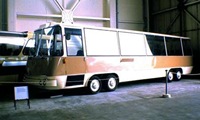 Vehicle reminder shot for this posting
Vehicle reminder shot for this posting
19/11/16 – 13:35
More details for the Moulton coach may be found in "From Bristol to Bradford" the auto biography of Alex Moulton, highly recommended!
The original application of the suspension was not for passenger coaches but for lorries. A Thorneycroft lorry was adapted, the ride was found to be far too good for qa lorry and that Thorneycroft chassis was unsuitable (lacking stiffness) and exhibited axle-tramp. Alex Moulton personally funded the construction of the prototype coach.
The geodesic space frame of the coach gave a high degree of stiffness to the coach chassis, a lesson from the problems of axle tramp on the Thorneycroft. Moulton derived much pleasure from driving the coach on the proving grounds.
MM

